Creating a game / universe
You may create and save as many games (universes) as you
wish with TBCB 2.5. The makeup and structure of your universe can be
quite complex. By way of example, we will walk through the set up of a
very basic, narrow universe. First, from the main menu select the Create Boxing Universe button: 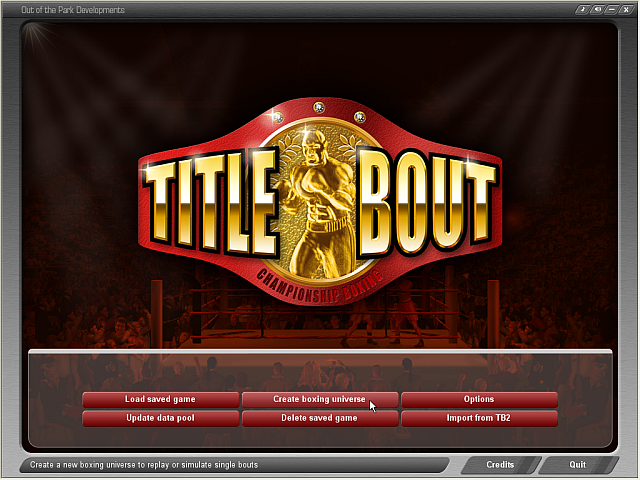
You will be asked to give your universe a unique name; we'll call ours 1970s Heavyweights: 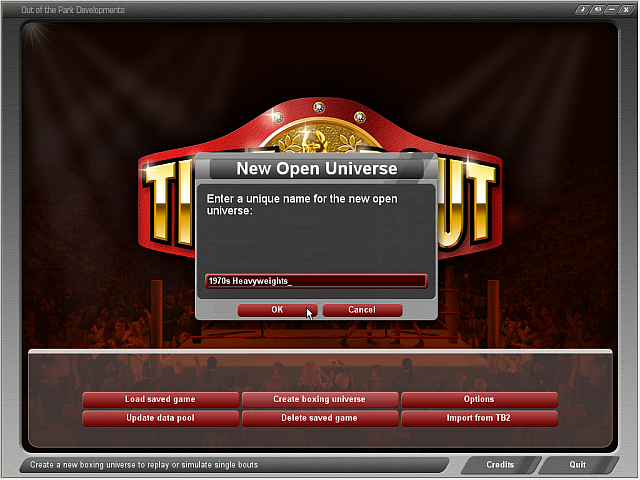
After
naming your universe and clicking OK, you will be presented with a
fighter filter dialog box. You may filter for gender, weight class and
career start. The selections made here will determine which
fighters will initially populate your universe. Once created, you
may bring into your universe new fighters by using the same fighter
filter dialog box. For our 1970s Heavyweight universe, we will
select all male heavyweights in the data pool who had their career
start between 1970 and 1975. New fighters or 'rookies' can be
imported when we reach 1976 in our simulation. The selections
shown below will filter the pool for just those fighters wanted. 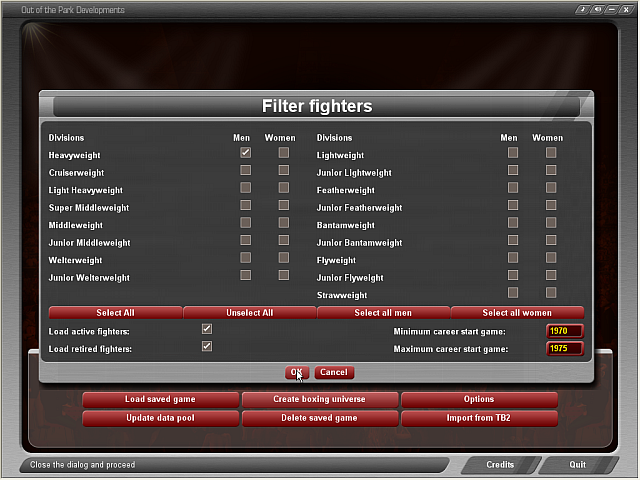
Clicking
OK will create the desired universe. What we have to start with then
will be all those selected fighters rated at prime and in this case
retired (given the era). Seen below is a poor screenshot of the
resulting universe to start with. There are 69 male heavyweights
in the database that began their career between 1970 and 1975. 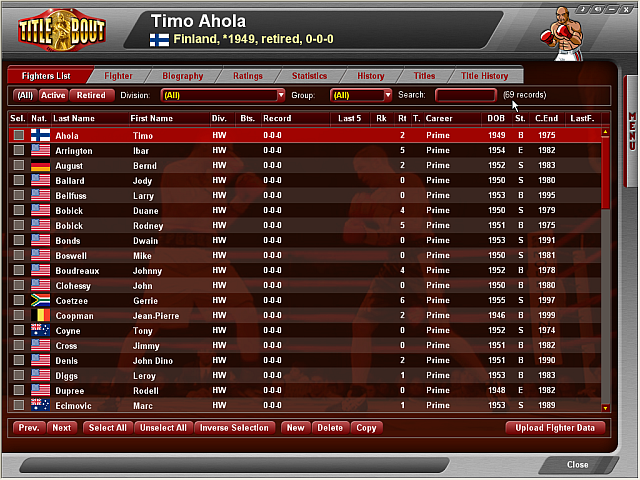
Now
we need to select our debutants for 1970 and set them to the beginning
career stage. (For a look at career stages and the settings used in this
sample universe see this ) First, check the boxes to the left of the fighters who started in 1970 and mouse over the side menu to the right as shown below. 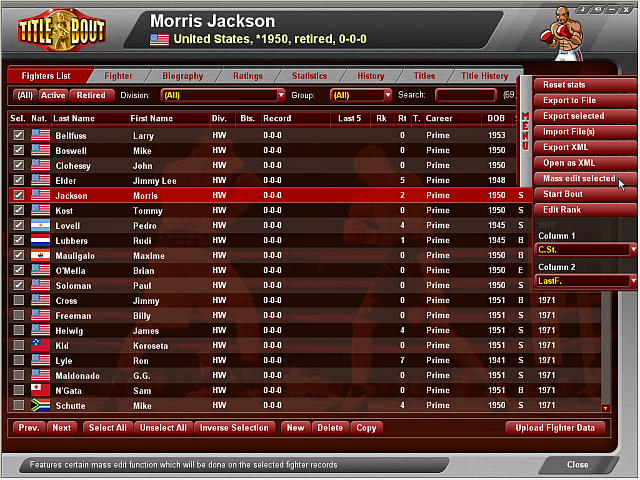
When
you mouse over the menu side bar, a larger menu will be
revealed. From this, click Mass Edit Selected. 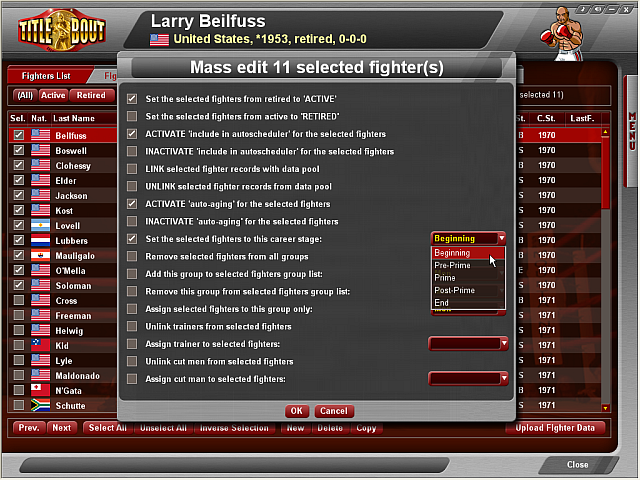
We
want all of these debuting fighters to be changed from retired to
active, activated for auto aging and to be given a beginning career
stage rating. Those selections are indicated in the selections shown
above. After clicking OK, our fighter screen will show all of the
1970 career start fighters as beginners while the fighters with career
starts ranging from 1971 to 1975 will still show that their prime rating
is the default. 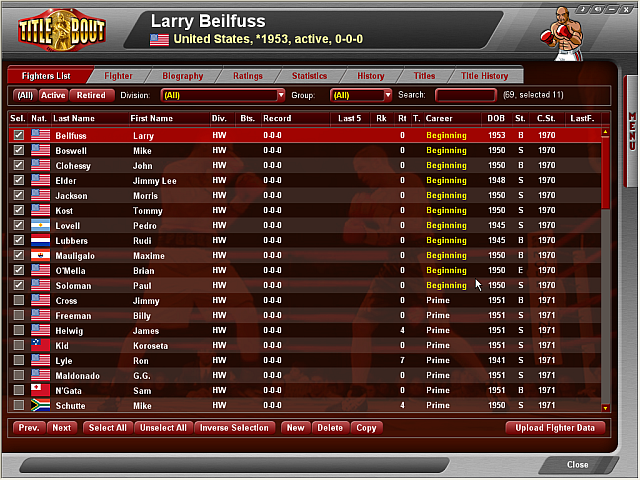
All
of these fighters appear because we have the 'All' button toggled in
the top left corner. We can filter out the currently unused
fighters by clicking the Active button. Doing so will filter
out the retired fighters leaving us just with the fighters who will
begin action in 1970. 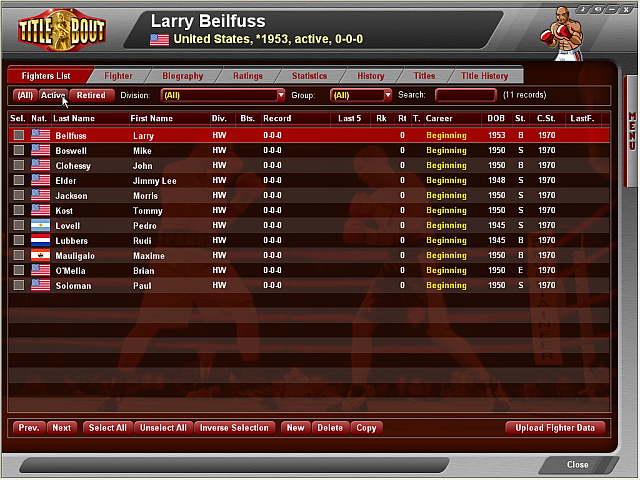
The
Universe now consists of 11 active fighters set to beginning career
stage. Those that debut in 1971 and later years will remain set as
retired and in the prime career stage until we reach 1971. You can
set up fights for these heavyweights by hand with the Start Fight,
Tournament or Fight Card selections at the top of your screen or
use the auto-scheduler. In this example, we will use the
auto-scheduler. Begin by clicking on the Scheduler tab in the top right
corner. 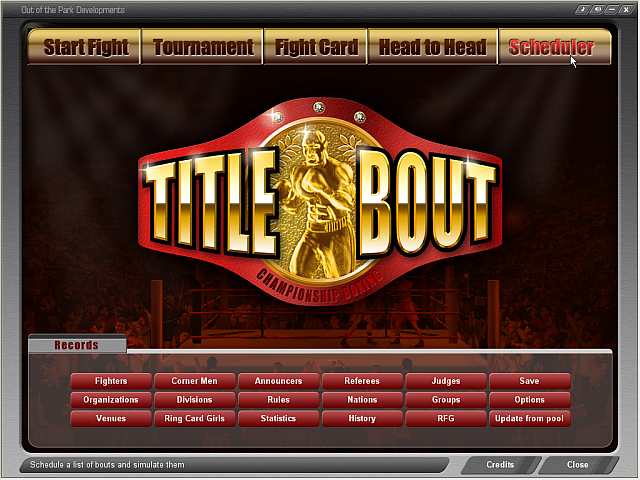
Next,
select Auto-scheduler as shown. (Note the Add button just to the left.
That selection allows you to add fights by hand one-by-one to build a
desired schedule that can then be auto-simmed.) 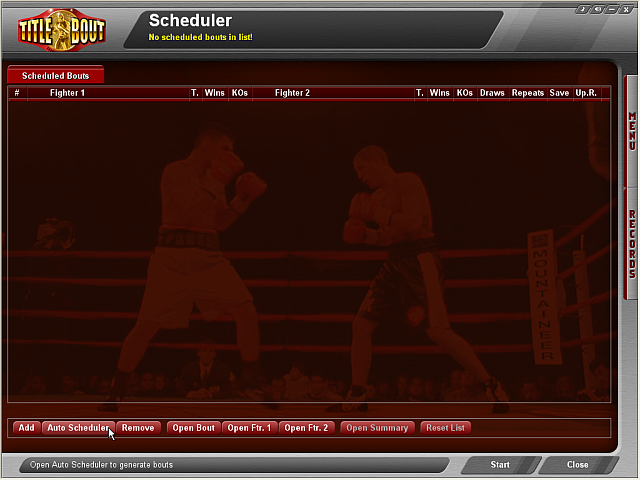
We will run this universe on a month-to-month basis. In the General tab, we will make the following selections: - Check to schedule each fighter only one time (this will avoid having two bouts in any given month). - Check to update fighter records so your fighters will retain their history. -
We are leaving the save bout logs box un-checked. If you want to save
them by all means do. We are not saving here so that you can see how to
selectively save them a bit later on - We have selected 1 for repeats (we only want one of each match-up to run) and 6 for the maximum number of bouts to run. -
We have selected men and combine only identical. This means that only
like-weight classes will be selected to oppose one another. - Our random fight year and month are set to January of 1970 The
blue and red corner tabs are where you can filter who the scheduler
will select for each random fight. You can set one group against
another, ensure that fighters with few bouts will only face low rated
fighters and so forth. In our example, we have only a few
fighters at the moment so we want them all to be in the mix. However, we
do not want our yet-to-debut fighters (currently set as retired) to get
any fights. With that in mind, we make the following selections on both
the Red and Blue corner tabs. - We selected Active and HW. This will ensure that the heavyweights set to retired will not be selected -
We added 45 to days inactive field. This will force fighters to take at
least a month off between bouts (they should get no more than 6 in a
given year). 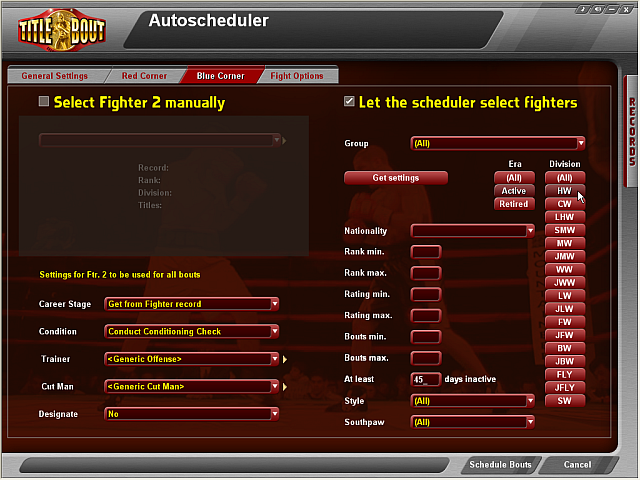
After
the options are set, click the Schedule Bouts button and the game will
select fights based upon your criteria. The screen below shows that five
bouts have been selected for January of 1971. Note the absence of
checks in the Save column. If you decide that you want to save one or
more of the bout logs, you can do that here as well as making the global
decision back on the general tab. All fights are checked for updating
so these bouts will count. To sim these bouts in a few seconds,
just click the Start button at the bottom. 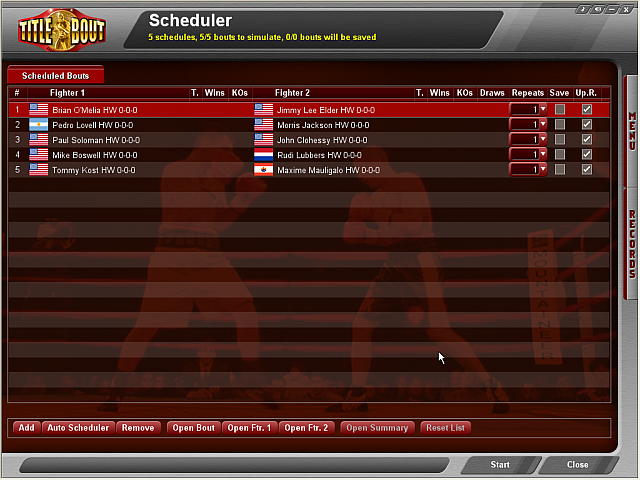
After
the January fights have been run, you can go through the rest of 1971
by going back to the general tab and changing the random fight date
month. All your other options will stay the same in this example
so 12 months can be run in just a few minutes. The fighter screen
shown below is after running just January. You can see that all fighters
with the exception of one had a fight in January of 1971. 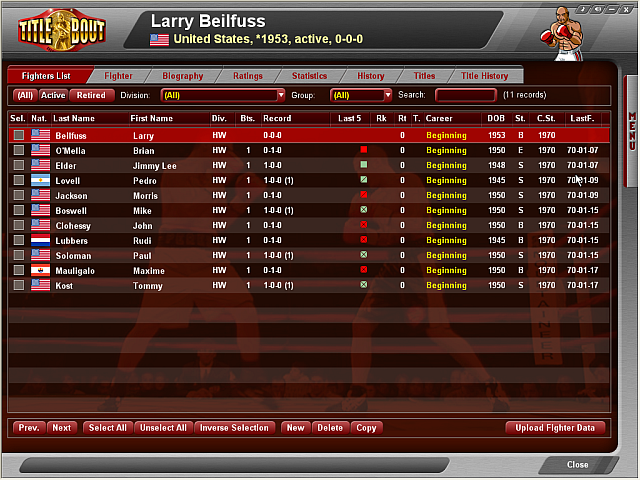
After
simming all 12 months, the same fighter screen is shown below. Note
that through random selection, all 11 fighters had between 5
and 6 bouts for the year. Our auto-aging was set to step up to the
pre-prime stage after 2 to 4 bouts so all of these fighters have made
that step. 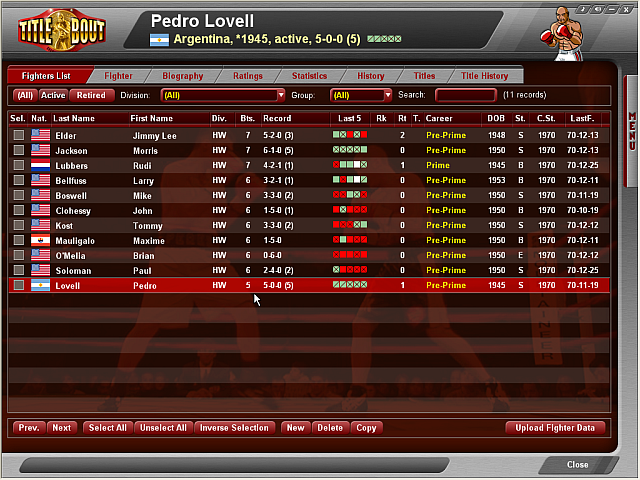
As
we enter 1971, we will want to bring the new debutants into the
universe. By clicking the All button to the left you will be able
to see all fighters both active and retired. Sort by career start simply
by clicking the header in that column and check off all those with a
1971 start. You then can go through the same mass edit procedure
described above to convert these fighters to active beginners. 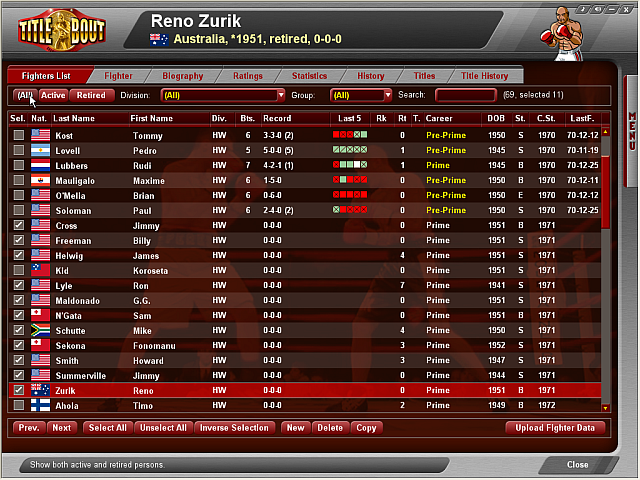
After
completing the mass edit, your fighter screen will look like this. Note
that those fighters with a 1971 career start are set to beginner career
stage. 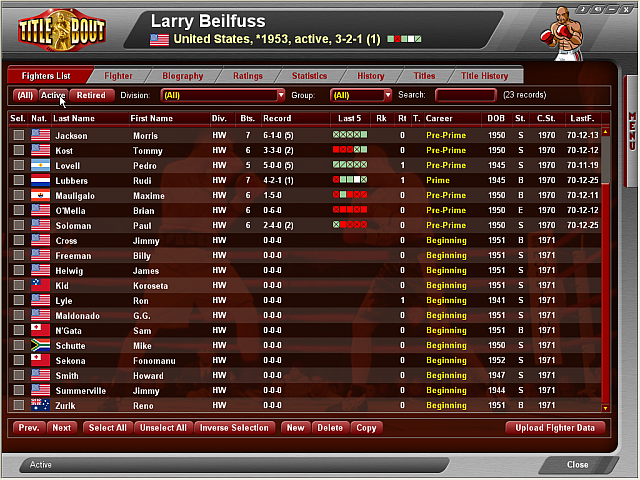
By
repeating this process for each year, you will have a foundation built
for your universe. As the years progress more fighters will be active so
you will want to alter the number of fights scheduled each month to
regulate the number of bouts per year a fighter will have. In this
example, the number started at six and was gradually raised to 12. At
the end of 1975 there were 69 active fighters in the universe. Only
those with 10 or more fights are eligible to be ranked in this example
which generated the following rankings as of December 31, 1975: The top of the class 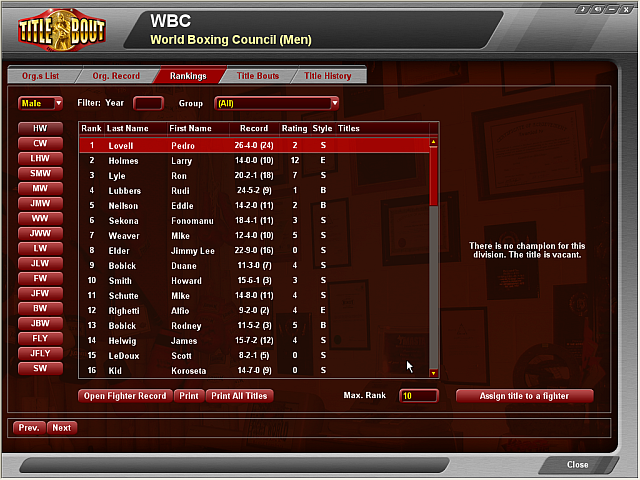
The middle of the pack 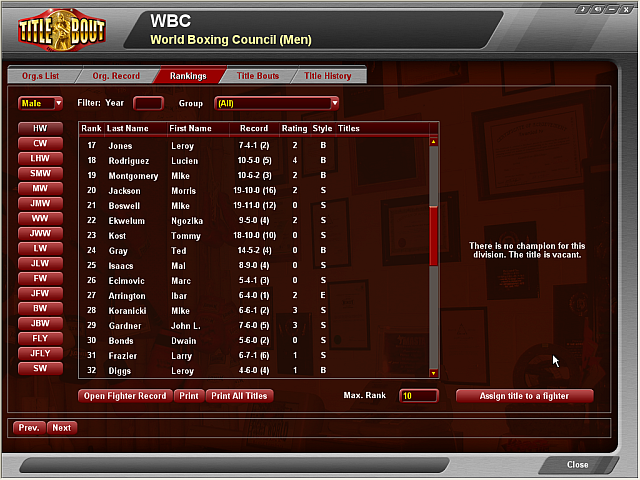
And, the bottom feeders 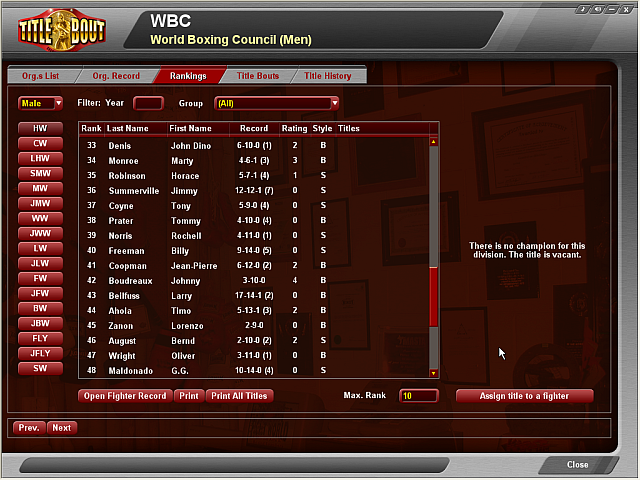
After
five years in this example, 59 fighters have ten or more bouts and
are ranked while 10 have less than ten bouts and are not. At
this point, you can bring in 1976 rookies through the fighter filter
and continue on. Perhaps a world title fight will be on the horizon,
perhaps you will open up other sanctioning bodies and segregate fighters
into new groups; the choice is all yours.
| 
